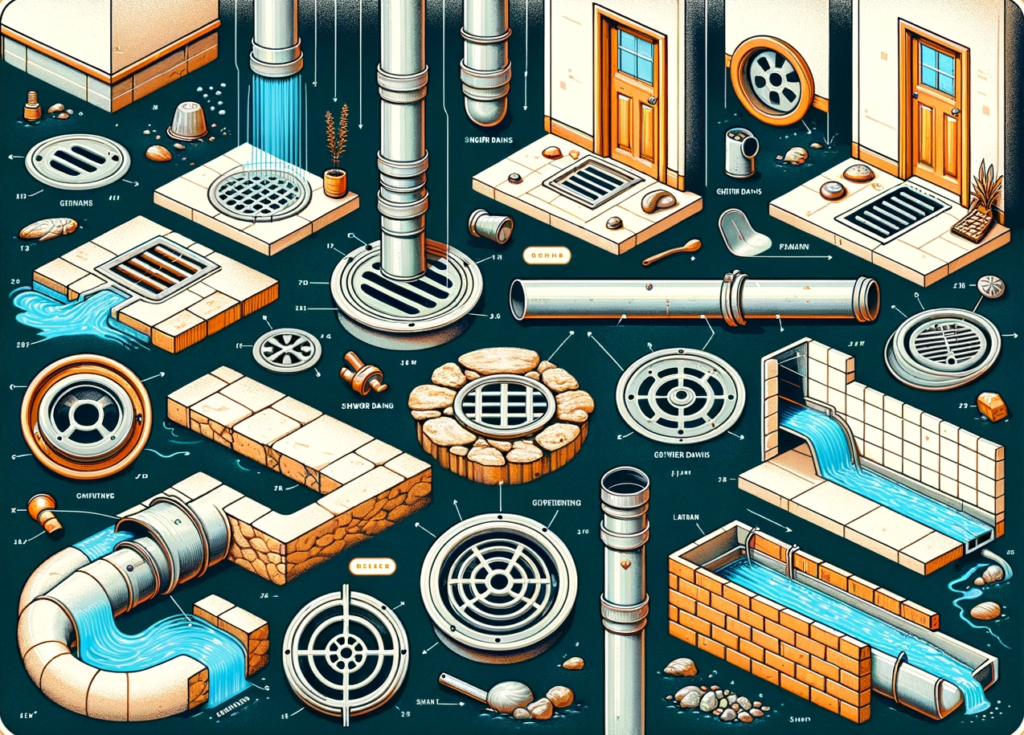Types of Drains and Their Features: An In-Depth Guide

Drains play a crucial role in buildings, managing water flow, preventing potential flooding, and ensuring sanitation. With various drains available, understanding their types, features, and functions becomes essential. This guide covers the diverse types of drains, delving deep into their features, common problems, and more.
Bathtub and Tub Drains

Description:
Bathtub drains are pivotal, directing water from tubs to the sewage system, ensuring an uninterrupted bathing experience.
Types:
- Pop-up: Lever-operated, they can open and close to retain or release water.
- Lift-and-turn: Manually twisted to control water flow.
- Push-and-pull: Simply pushed down or pulled up to control water flow.
Features:
- Manufactured from corrosion-resistant materials like stainless steel or brass.
- Most designs include a built-in overflow assembly for safety.
FAQs:
- Why isn’t water draining from my bathtub?
- Common culprits are hair and soap buildup. Regular cleaning helps.
- Can I replace my tub drain by myself?
- DIY is possible, but hiring a professional is advised if you’re unfamiliar with the process.
- How often should bathtub drains be cleaned?
- Clean monthly or when you notice slow drainage.
- Can hair clogs damage my bathtub drain?
- Prolonged hair clogs can cause wear, potentially leading to leaks.
Common Problems & Solutions:
- Slow draining: Often due to blockages. Regular cleaning and using a drain protector help.
- Lever malfunction in pop-up drains: Worn-out components may need replacement.
Maintenance Tips:
- Periodically clean the stopper.
- Use baking soda and vinegar for deep cleaning.
Innovations and Future:
The next-gen tub drains might feature auto-clog detection, self-cleaning mechanisms, and integration with smart homes for enhanced convenience.
Kitchen and Bathroom Sink Drains

Description:
Sink drains, fundamental in kitchens and bathrooms, manage water outflow and often incorporate strainers to capture debris, ensuring a smooth and clog-free drainage.
Types:
- Basket strainer: Widely used in kitchens due to its basket-like design.
- Grid drain: Lacks moving parts, making it a common choice for bathrooms.
- Pop-up drain: Found in many bathrooms, it operates through a lever mechanism.
Features:
- Often constructed from durable materials like stainless steel or brass, ensuring longevity.
- Bathroom sink drains usually include overflow holes as a safety feature.
FAQs:
- How can I maintain a stink-free kitchen sink?
- Regular cleaning and avoiding disposing of food particles down the sink help.
- My bathroom sink drain seems slow. Why?
- Hair, soap, and debris can reduce flow. Regular cleaning addresses this.
Common Problems & Solutions:
- Odor issues: Caused by trapped food or debris. Cleaning is the remedy.
- Reduced water flow: Mineral build-up in hard water areas can be a cause. Descales help.
Maintenance Tips:
- Clean the strainer regularly.
- Flush with boiling water monthly to prevent buildups.
Innovations and Future:
Future sinks might boast sensors to detect blockages early or even have self-cleaning features, making maintenance a breeze.
Floor Drains

Description:
Found in garages or basements, these drains handle water overflow and prevent potential flooding.
Types:
- Round: Traditional circular design.
- Square: Modern aesthetic, often in contemporary homes.
- Linear: An extended linear design, commonly used in modern showers.
Features:
- Include grates to prevent large debris entry.
- Designed with traps to block sewer gases.
FAQs:
- Why does my floor drain smell bad?
- A dried-out trap might be the culprit. Pouring water can help.
- Can I cover my floor drain?
- While covers can be used, ensuring the drain remains accessible is crucial, especially during water overflows.
Common Problems & Solutions:
- Standing water around the drain: This might indicate a clog or an issue with the slope during installation.
- Foul smell of sewer gas: Regularly ensure the trap contains water to block sewer gases.
Maintenance Tips:
- Regularly check for debris.
- Ensure there’s always some water in the trap to prevent the entry of sewer gases.
Innovations and Future:
Emerging floor drains might incorporate smart alerts for potential flooding or even auto-cleaning systems to reduce manual maintenance.
Materials Used in Drains
Drains are crafted from a variety of materials, each tailored to specific applications and environments.
- PVC: Lightweight and resistant to corrosion, PVC is frequently used in residential settings due to its cost-effectiveness and easy installation.
- Brass: Known for its aesthetic appeal and durability, brass is a preferred choice for upscale installations and can withstand decades of use.
- Stainless Steel: With a modern, sleek appearance and exceptional strength, stainless steel is ideal for both residential and commercial environments. Its resistance to rust and staining makes it a favorite for kitchens and outdoor settings.
The Importance of Drain Grates
Drain grates serve as the first line of defense in maintaining an efficient drainage system.
- Debris Prevention: Their primary function is to trap larger debris, preventing clogs and ensuring smooth water flow.
- Safety: Drain grates also play a pivotal role in safety. An open drain can be a hazard, especially in high foot traffic areas. Grates reduce the risk of accidents.
- Aesthetics: Modern grates come in various designs, adding to the visual appeal of the space.
Innovative Drain Designs & The Future of Drains
The drainage industry is not exempt from the wave of innovation sweeping across various sectors.
- Smart Drains: With IoT integration, future drains might alert homeowners about potential blockages or even predict when maintenance is due.
- Eco-friendly Designs: Sustainable drains that focus on water conservation and reduce wastage are on the horizon. Some designs might even recycle water for other uses.
The Economic Impact of Proper Drainage
A functional drainage system plays a more significant role than merely convenience.
- Property Protection: Effective drainage can prevent potential water damage, saving homeowners thousands in repairs.
- Increased Property Value: A well-maintained drainage system can be a selling point, potentially boosting property value.
- Reduced Maintenance Costs: Regularly maintained drains reduce the frequency of costly professional cleanings and repair.
Conclusion
From managing water in bathtubs to preventing floods in basements, understanding the types, features, and maintenance needs of each drain type is crucial. As technology evolves, so do the functionalities and designs of drains, ensuring they continually meet the ever-changing needs of modern households.




